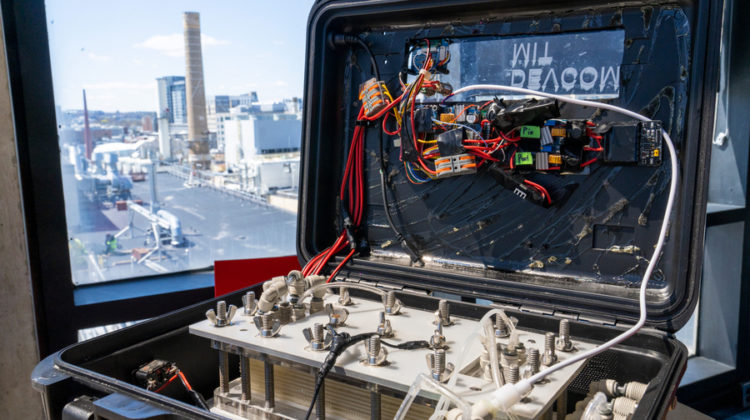
Researchers at MIT have developed a portable filter-less desalination unit that weighs less than ten kilograms and can remove particles and salts to generate drinking water that exceeds World Health Organization quality standards.
The suitcase-sized, user-friendly device, which requires less power to operate than a mobile phone charger, can also be driven by a small, portable solar panel costing about US$50.
Unlike other portable desalination units, which require water to pass through filters, the device utilises electrical power to generate drinking water. Eliminating the need for replacement filters greatly reduces the long-term maintenance requirements, which means that it could be deployed in remote and severely resource-limited areas or in the aftermath of a natural disaster.
‘This is really the culmination of a ten-year journey that I and my group have been on,’ said Jongyoon Han, a professor of electrical engineering, computer science and biological engineering, and a member of the Research Laboratory of Electronics (RLE). ‘We worked for years on the physics behind individual desalination processes, but pushing all those advances into a box, building a system and demonstrating it in the ocean – that was a really meaningful and rewarding experience for me.’
Commercially available portable desalination units typically require high-pressure pumps to push water through filters, which are very difficult to miniaturise without compromising the energy-efficiency of the device. The new unit relies on a technique called ion concentration polarisation (ICP), which was pioneered by Han’s group more than a decade ago. Rather than filtering water, the ICP process applies an electrical field to membranes placed above and below a channel of water. The membranes repel positively or negatively charged particles – including salt molecules, bacteria and viruses – as they flow past. The charged particles are funnelled into a second stream of water that is eventually discharged.
The process removes both dissolved and suspended solids, allowing clean water to pass through the channel. Because it only requires a low-pressure pump, ICP uses less energy than other techniques.
However, ICP doesn’t always remove all of the salts travelling in the middle of the channel, so the researchers incorporated a second process, known as electrodialysis, to remove the remaining salt ions.
The team used machine learning to find the ideal combination of ICP and electrodialysis. The optimal setup includes a two-stage ICP process, with water flowing through six modules in the first stage then through three in the second stage, followed by a single electrodialysis process. This minimised energy usage while ensuring that the process remains self-cleaning.
‘While it is true that some charged particles could be captured on the ion exchange membrane, if they get trapped, we just reverse the polarity of the electric field and the charged particles can be easily removed,’ said Junghyo Yoon, a research scientist in the RLE.
By shrinking and stacking the ICP and electrodialysis modules, the researchers were able to improve their energy efficiency and to fit them inside a portable device. The device was specifically designed for non-experts, with just a single button to launch the desalination and purification process. Once the salinity level and the number of particles decrease to specific thresholds, the device notifies the user that the water is drinkable.
The researchers also created a smartphone app that can control the unit wirelessly and report real-time data on power consumption and water salinity.
The team field-tested a prototype of the device at Boston’s Carson Beach. In about half an hour, the device had filled a plastic drinking cup with clear, drinkable water, havingreduced the amount of suspended solids by at least a factor of ten.
‘It was successful even in its first run, which was quite exciting and surprising,’ said Han. ‘But I think the main reason we were successful is the accumulation of all these little advances that we made along the way.’
The prototype generates drinking water at a rate of 0.3 litres per hour, and requires only 20 watt-hours per litre. ‘Right now, we are pushing our research to scale up that production rate,’ Yoon said.
The research has been published online in Environmental Science and Technology.



